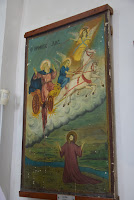(...)
We then headed towards St. Barnabas' Monastery, which was erected in 477 near the spot where the Apostle's grave was discovered. The construction is said to have been financed by the Byzantine Emperor Zeno himself, though two centuries later it was demolished in one of the devastating Arab raids on Cyprus.
What remains of that former construction are the foundations of the original Byzantine edifice, once the present Church and Monastery are said to have been constructed in 1756, on the orders of Archbishop Philotheos during the Ottoman rule, now housing an Icon Museum.
What remains of that former construction are the foundations of the original Byzantine edifice, once the present Church and Monastery are said to have been constructed in 1756, on the orders of Archbishop Philotheos during the Ottoman rule, now housing an Icon Museum.

Over the years the number of resident monks reduced and by the 1950s it is known only three brother monks remained. They were the ones who dedicated themselves to the Church premises, with much of their time spent painting many of the frescoes and icons which are in display.
Some of the frescoes we came across on the right hand side by the entrance depict some of the Saint's life episodes including the discovery of the location of his tomb and his body following a dream by Bishop Anthemios. Although some were in a fairly bad state the expressions on many of the depicted figures touched me.







Because we wouldn't have enough time to thoroughly look at every icon Michel drew our attention to the ones which deserved to be looked at because of either the meaning of some of the iconographic representations or some sort of unique detail.












(To be continued)




















No comments:
Post a Comment